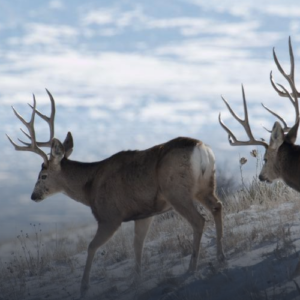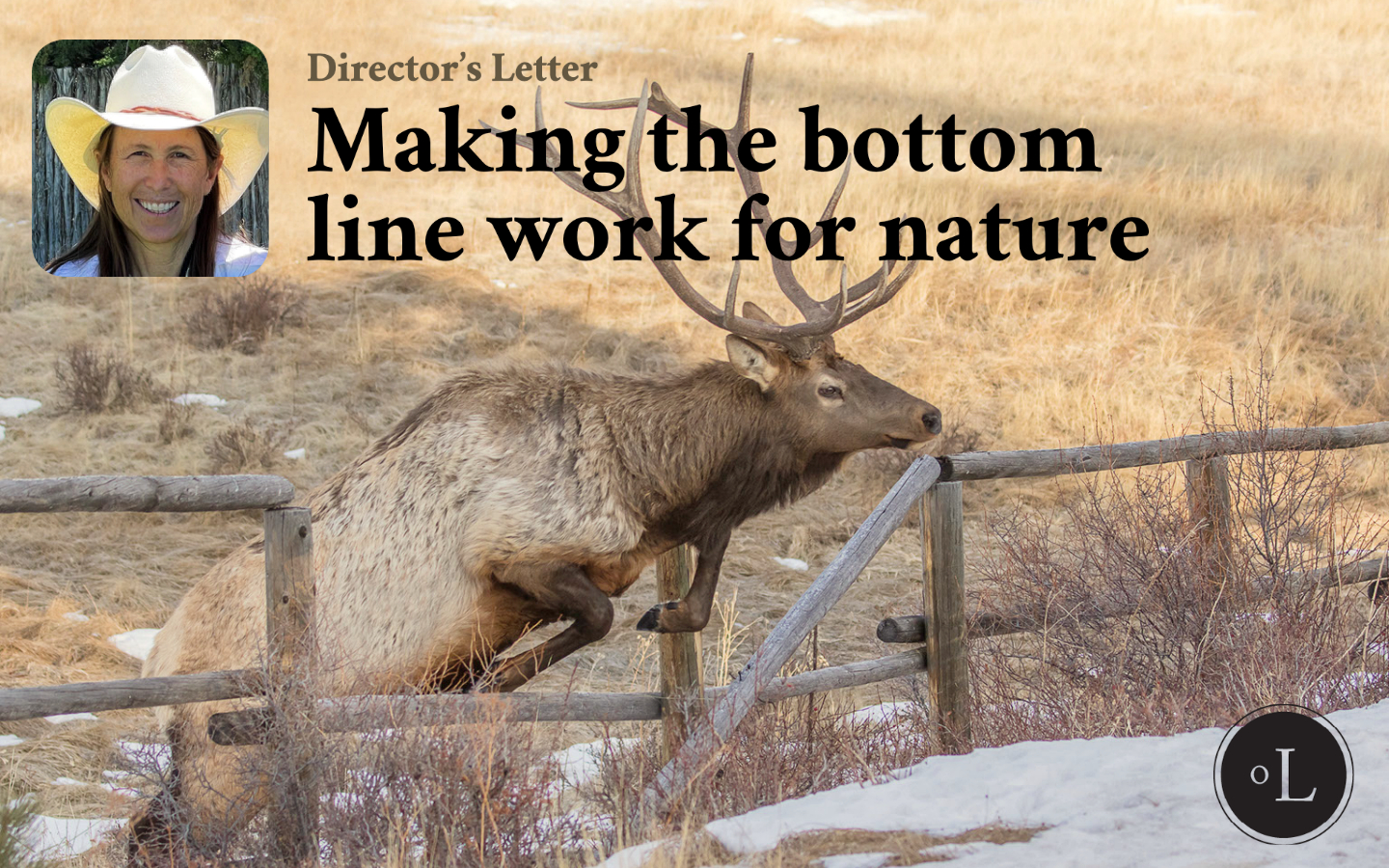DETAILS
A simple, proven model, applied at scale.
Working lands provide much of the essential habitat many species of wildlife need to survive. Most landowners appreciate wildlife and understand that well-managed land can be a benefit to both wildlife and livestock. However, in some instances, supporting public wildlife can also come at a significant cost to the private landowner. A habitat lease recognizes and compensates landowners and producers for providing public values at private cost. These costs can include such things as competition for forage and disease transmission between ungulates and livestock, damages to hay and fencing, livestock depredation, water-conserving measures, management changes to accommodate wildlife needs, and opportunity cost (e.g. foregoing more lucrative land uses such as development).
How does it work?
The leasing of land for a variety of purposes is long familiar to the agricultural community. Farmers and ranchers lease pasture for grazing, hay production, conservation, energy development, hunting and other public access. Similarly, habitat leasing is a negotiated agreement between a landowner and a lessee in which the landowner receives compensation for providing products or services that benefit public wildlife for a specific amount of time. Lessees can include individuals, businesses, non-profit organizations, charitable funders, government agencies, or a combination of interested parties.
Who should pay to support wildlife?
Human activity has displaced wildlife and habitat from urban areas, transportation corridors, energy and industrial development zones and recreation areas, yet society, as a whole, has done little to account or pay for these impacts. Private lands in the U.S. today provide essential habitat and refuge for up to 80% of wildlife species. Yet as private lands continue to be developed or converted to more intensive forms of use, pressure is increasing on those that remain to sustain what’s left of wildlife and their habitats. This pressure, in turn, can create financial and regulatory hardships on landowners that drive more land into development. Habitat leasing spreads the costs of sustaining public wildlife so that landowners can afford to keep essential habitats intact. Funding for habitat leases can be made available through tax supported government programs, business and charitable contributions, impact and user fees, or a combination of funding sources.
Is a habitat lease compatible with agricultural activities?
Yes, in most cases. Well-managed farms and ranches are already providing habitat to many species, though are often uncompensated for the associated costs. At its most basic level, habitat leasing simply requires that the landowner provide quality habitat that is accessible to wildlife. In some cases, adjustments in management may be needed, such as altering rotation of livestock to accommodate seasonal wildlife needs and to ensure adequate forage and cover remain available. In other cases, management may already be adequately accommodating wildlife needs. Each lease is unique and voluntary, and the terms are negotiated between the landowner and the lessee. In some cases, landowners can receive additional compensation for improving habitat or infrastructure (e.g., installing wildlife-friendly fencing).
How does a habitat lease compare to a perpetual conservation easement?
A perpetual conservation easement is a voluntary agreement by a landowner to permanently retire the rights to develop all or a portion of their land, typically in exchange for tax credits or direct payment. A habitat lease, on the other hand, provides annual payments to the landowner over a specified period of time for land use and management practices that supply quality habitat. A landowner may have both a conservation easement, which protects land from development, and a habitat lease, which provides annual income. Similarly, many agricultural landowners have conservation easements and also lease land for crop production, livestock grazing and recreational access.
Heard the news and looking to sign up?
Start with your local FSA office. If you have issues or need assistance, please contact WLA - 505.466.1495 - leave a voicemail and someone will get back to you!
WHAT'S AT STAKE
Critical habitat for wildlife in the West is disappearing at an alarming rate
Well-managed private lands are the cornerstones of both human communities and functioning ecosystems. These lands provide numerous public benefits beyond production of food and fiber, including wildlife habitat, carbon sequestration, healthy watersheds, clean air, open space and public health.
Yet private lands, including family farms, ranches and timberlands, are under immense pressure from both natural and man-made forces. Thin profit margins, volatile commodity markets, increasing regulation, wildlife needs and climate change impacts such as severe drought, flood events, wildfire and invasive species are driving these lands into development and converting them to other land uses. Once these lands are fragmented and developed, there is no getting back the ecosystem services they once provided. In the American West, these lands are disappearing at an alarming rate, as one football field worth of land is lost to development every two and a half minutes.
The responsibility and cost of caring for wildlife and ecosystems cannot be borne by landowners alone but must be shared by all parts of society and all levels of government.
BIG CHANGE IS HAPPENING
USDA expands habitat leasing to Idaho and Montana, building on WLA-led pilot in Wyoming
On June 27th, 2023, the U.S. Department of Agriculture (USDA) announced major changes and $500 million in new investments that recognize and support the vital role that working lands play in sustaining wildlife. The funding will support and expand the Natural Resource Conservation Service (NRCS) Working Lands for Wildlife (WLFW) program.
The investment builds on the successes of the USDA-Wyoming Big Game Partnership Pilot, in which Western Landowners Alliance has been closely involved since inception. In the western U.S., at least $40 million will go toward the continuation of that pilot and an expansion to the neighboring states of Idaho and Montana. Importantly, the agency is also staffing up through a major hiring initiative.

Partnership in Wyoming
Wyoming migration fund to benefit working lands, big game habitat
Western Landowners Alliance is thrilled to announce that we are the recipient of grant funding to support habitat leasing in Wyoming! The WYldlife Fund, a nonprofit partner of the Wyoming Game and Fish Department, announced the first recipients of grant funding from its new Pooled Migration Fund. The grant funding is intended to enhance voluntary conservation of private, working lands and Tribal lands within big game migration corridors.
Wyoming and USDA agree on innovative partnership to conserve wildlife
October 17, 2022
WLA Press Release
Washington, DC – This afternoon, Agriculture Secretary Tom Vilsack and Wyoming Governor Mark Gordon signed a memorandum of understanding that ratifies a partnership between the state of Wyoming and the U.S. Department of Agriculture to conserve big game migrations and other wildlife habitat.
The “Partnership to Support Big Game Working Lands Conservation in Wyoming” commits the USDA to a package of new opportunities for landowners in Wyoming. In addition to an increased commitment of $16 million in FY23 for restoration and preservation of agricultural lands, the agency will pilot an innovative “habitat leasing” initiative under the federal Grasslands CRP program.
Habitat leases are a tool, identified by Governor Gordon’s migration corridors task force, as a common-ground solution that makes it possible for working ranches to stay in business ranching while also providing the critical habitat elk and other wildlife require for survival. Private landowners who choose to enroll in the program agree to maintain quality habitat over a 10-15 year contract period in exchange for annual payments on a per acre basis. Livestock grazing is permitted to continue under a management plan compatible with wildlife.
Western landowners applaud USDA and Wyoming for launch of habitat lease partnership around Yellowstone
May 20, 2022
WLA Press Release
Cody, Wyoming – Today, the U.S. Department of Agriculture (USDA) announced a new partnership with the state of Wyoming to conserve habitat for big game migrations on private land surrounding Yellowstone National Park. The announcement came as part of the celebration of Yellowstone National Park’s 150th anniversary.
Along with investments in agricultural land protection and restoration, The “Partnership to Support Big Game Working Lands Conservation in Wyoming” commits USDA to the innovative application of Farm Bill conservation title programs to develop habitat leases on private land. Habitat leases are a tool that provide needed economic certainty to farms and ranches (“working lands”), while allowing the flexibility to tailor terms to local situations.
“Landowners appreciate wildlife and are essential partners in providing much of the West’s most important habitat,” said Zach Bodhane, Western Landowners Alliance policy director. “However, sustaining wildlife can also come at significant economic cost. If we want to support landowners that choose to manage land in ways that benefit wildlife, we need creative solutions like habitat leasing to help offset those costs and keep these working lands intact.”
Examples
Grassland CRP
USDA rental payment and cost-share assistance program
Under this program, landowners and operators can protect grassland, including rangeland and pastureland and certain other lands, while maintaining the areas as grazing lands. The program emphasizes support for grazing operations, plant and animal biodiversity and grassland and land containing shrubs and fobs under the greatest threat of conversion. Contract duration is between 10 and 15 years.
Chaffee Common Ground
County-level sales tax increase devoted to term conservation agreements with landowners
Chaffee County in Colorado approved a 0.25 percent sales tax increase to fund a number of conservation initiatives, including working lands stewardship. A portion of the sales tax proceeds have been awarded to keep working lands in production through conservation agreements with landowners and programs that support agricultural sustainability.
